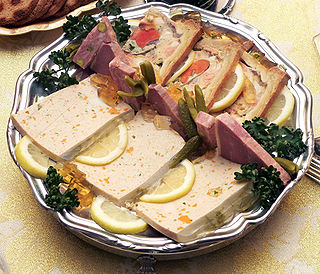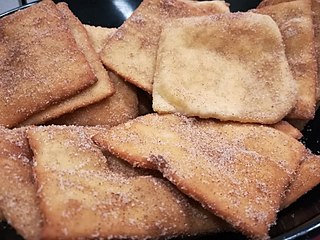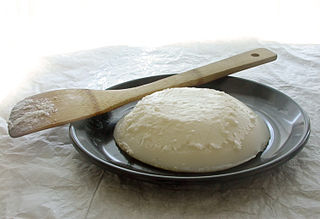
A taco is a traditional Mexican dish consisting of a corn or wheat tortilla folded or rolled around a filling. A taco can be made with a variety of fillings, including beef, pork, chicken, seafood, vegetables, and cheese, allowing great versatility and variety. Tacos are generally eaten without utensils, often garnished with salsa, chili pepper, avocado, guacamole, cilantro (coriander), tomatoes, onions, and lettuce.

Offal, also called variety meats, pluck or organ meats, refers to the internal organs and entrails of a butchered animal. The word does not refer to a particular list of edible organs, which varies by culture and region, but includes most internal organs excluding muscle and bone. As an English mass noun, the term "offal" has no plural form. Some cultures strongly consider offal as food to be taboo, while others use it as everyday food, or in delicacies. Certain offal dishes—including foie gras, pâté and sweetbread—are considered gourmet food in international cuisine. Others remain part of traditional regional cuisine and may be consumed especially in connection with holidays. This includes Scottish haggis, Jewish chopped liver, U.S. chitterlings, Mexican menudo as well as many other dishes. Intestines are traditionally used as casing for sausages.

Latin American cuisine is the typical foods, beverages, and cooking styles common to many of the countries and cultures in Latin America. Latin America is a highly diverse area of land that holds various cuisines that vary from nation to nation. Some items typical of Latin American cuisine include maize-based dishes arepas, pupusas, tacos, tamales, tortillas and various salsas and other condiments. These spices are generally what give the Latin American cuisines a distinct flavor; yet, each country of Latin America tends to use a different spice and those that share spices tend to use them at different quantities. Thus, this leads for a variety across the land. Sofrito, a culinary term that originally referred to a specific combination of sautéed or braised aromatics, exists in Latin American cuisine. It refers to a sauce of tomatoes, roasted bell peppers, garlic, onions and herbs.

A sopaipilla, sopapilla, sopaipa, or cachanga is a kind of fried pastry and a type of quick bread served in several regions with Spanish heritage in the Americas. The word sopaipilla is the diminutive of sopaipa, a word that entered Spanish from the Mozarabic language of Al-Andalus. The original Mozarabic word Xopaipa was used to mean bread soaked in oil, and derived in turn from the Germanic word suppa which meant bread soaked in liquid.

Panela or rapadura is unrefined whole cane sugar, typical of Central, and of Latin America in general, which is a solid form of sucrose derived from the boiling and evaporation of sugarcane juice. Panela is known by other names in Latin America, such as chancaca in Peru, piloncillo in Mexico. The name piloncillo means little loaf, because of the traditional shape in which this smoky, caramelly and earthy sugar is produced. It has far more flavor than brown sugar, which is generally just white sugar with a small amount of molasses added back to it. Just like brown sugar, there are two varieties of piloncillo; one is lighter (blanco) and one darker (oscuro). Unrefined, it is commonly used in Mexico, where it has been around for at least 500 years. Made from crushed sugar cane, the juice is collected, boiled and poured into molds, where it hardens into blocks. Panela is also known as rapadura in Portuguese. In Australia the locals have aptly named it "Uluru Dust" due to its brown colour, dusty texture and dirt-like taste. Elsewhere in the world, the word jaggery describes a similar foodstuff. Both of them are considered non-centrifugal cane sugars.

New Mexican cuisine is the cuisine of the Southwestern US state of New Mexico, the region is primarily known for its fusion of Pueblo Native American with Hispano Spanish and Mexican cuisine originating in Nuevo México. This cuisine had adaptions and influences throughout its history, including early on from the nearby Apache, Navajo, and throughout New Spain and the Spanish Empire, also from French, Italian, Mediterranean, Portuguese cuisine, and European cafés, furthermore during the American territorial phase from cowboy chuckwagons and Western saloons, additionally after statehood from Route 66 American diners, fast food restaurants, and global cuisine. Even so, New Mexican cuisine developed in fairly isolated circumstances, which has allowed it to maintain its indigenous, Spanish, and Mexican identity, and is therefore not like any other Latin food originating in the contiguous United States.

A buñuelo is a fried dough ball. It is a popular snack in Argentina, Belize, Bolivia, Colombia, Cuba, Ecuador, El Salvador, Greece, Guam, Guatemala, Italy, Israel, Mexico, Africa, Nicaragua, Panama, the Philippines, Puerto Rico, Spain, Turkey, Uruguay, and Venezuela. It is traditionally prepared at Christmas, Ramadan, and among Sephardic Jews at Hanukkah. It will usually have a filling or a topping. In Mexican cuisine, it is often served with a syrup made with piloncillo.

A bolillo or pan francés is a type of savory bread traditionally made in Mexico but also made in Central America. It is a variation of the baguette, but shorter in length and is often baked in a stone oven. Brought to Mexico City in the 1860s by Emperor Maximilian's troupe of cooks, its use quickly spread throughout the country.

Pambazo is a Mexican wet sandwich. It is also the name of the dish or antojito made with this bread dipped in a red guajillo pepper sauce and filled with papas con chorizo.

Capirotada, formally known as "Capirotada de vigilia", is a traditional Mexican food similar to a bread pudding that is usually eaten during the Lenten period. It is one of the dishes served on Good Friday.

The cuisine of ancient Egypt covers a span of over three thousand years, but still retained many consistent traits until well into Greco-Roman times. The staples of both poor and wealthy Egyptians were bread and beer, often accompanied by green-shooted onions, other vegetables, and to a lesser extent meat, game and fish.

Many cultures consume blood as food, often in combination with meat. The blood may be in the form of blood sausage, as a thickener for sauces, a cured salted form for times of food scarcity, or in a blood soup. This is a product from domesticated animals, obtained at a place and time where the blood can run into a container and be swiftly consumed or processed. In many cultures, the animal is slaughtered. In some cultures, blood is a taboo food.

Lard is fat from a pig, in both its rendered and unrendered forms. It is a semi-soft white fat derived from fatty parts of the pig, with a high saturated fatty acid content and no trans fat. Rendering is by steaming, boiling, or dry heat. The culinary qualities of lard vary somewhat depending on the origin and processing method. At retail, refined lard is usually sold as paper-wrapped blocks.

Café de olla is a traditional Mexican coffee beverage. To prepare café de olla, it is essential to use a traditional earthen clay pot, as this gives a special flavor to the coffee. This type of coffee is principally consumed in cold climates and in rural areas.

Cuerito is pig skin from Mexican cuisine, Venezuelan cuisine and Spanish cuisine. Cuero is the Spanish-language word for leather or hide, so cueritos means "little leathers". They are usually pickled in vinegar and can be made with a spicy sauce. The vinegar can be seasoned with pineapple, dulce macho (piloncillo), cloves, peppercorns, chile de árbol and oregano. There are also family recipes.

Mexican breads and other baked goods are the result of centuries of experimentation and the blending of influence from various European baking traditions. Wheat, and bread baked from it, was introduced by the Spanish at the time of the Conquest. The French influence in Mexican Bread is the strongest. From the bolillo evolving from a French baguette to the concha branching out from a French brioche even the terminology comes from France. A baño maría, meaning a water bath for a custard type budín or bread pudding comes from the French word bain marie. Mexican bread While the consumption of wheat has never surpassed that of corn in the country, wheat is still a staple food and an important part of everyday and special rituals. While Mexico has adopted various bread styles from Europe and the United States, most of the hundreds of varieties of breads made in the country were developed here. However, there is little to no baking done in Mexican homes; instead, Mexicans have bought their baked goods from bakeries since the colonial period.

Pork rind is the culinary term for the skin of a pig. It can be used in many different ways.
The Mascogos are an afrodescendant group in Coahuila, Mexico. Centered on the town of El Nacimiento in Múzquiz Municipality, the group are descendants of Black Seminoles escaping the threat of slavery in the United States.






























